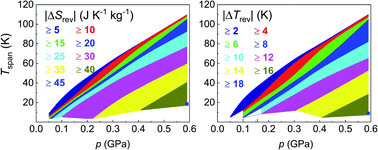Reversible barocaloric effects over a large temperature span in fullerite C60†
Abstract
Solid-state cooling methods based on field-driven first-order phase transitions are often limited by significant hysteresis and small temperature span, which increase the input work required to drive the cooling cycle reversibly and reduce the temperature range of operation. Here we show that giant reversible caloric effects can be driven using low hydrostatic pressures in the molecular crystal of fullerene C60 across its order–disorder first-order phase transition due to a small transition hysteresis and a high sensitivity of the transition to pressure. In particular, we obtain isothermal entropy changes ΔS = 25 J K−1 kg−1 under reversible application and removal of a pressure as low as p = 0.05 GPa. We also demonstrate that these features allow us to obtain these giant effects in a wide temperature span around room temperature which, furthermore, is desirable for single-component regenerative coolers. For a pressure change of p = 0.41 GPa, we obtain giant reversible values of ΔS = 31 J K−1 kg−1 and ΔT = 11 K, in a temperature interval larger than 50 K. This very good barocaloric performance postulates C60 as one of the best candidates known so far to be considered by engineers for the development of barocaloric devices. The physics underlying these caloric effects is also analyzed.



 Please wait while we load your content...
Please wait while we load your content...